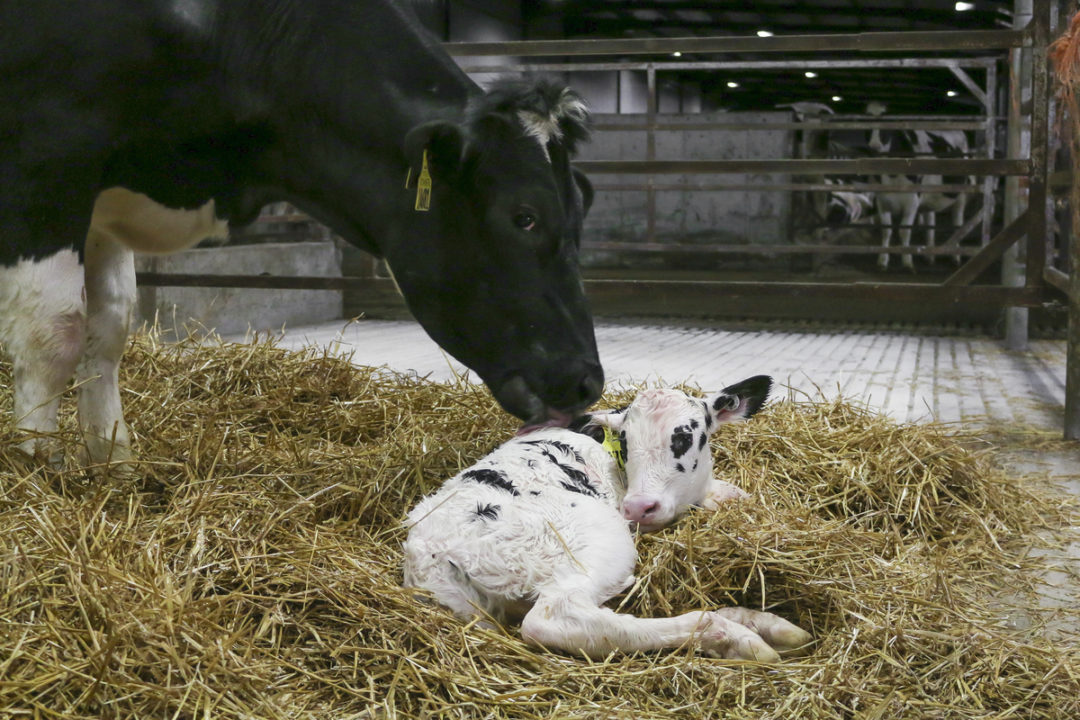In 2021, the National Academies of Sciences, Engineering and Medicine (NASEM) published the 8th Edition of the Nutrient Requirements of Dairy Cattle (NRC). As with past publications, the NASEM 2021 was developed based upon the foundation of previous editions of the NRC publication and important updates reflecting scientific advances in nutrition and feeding programs for dairy cattle since the last publication in 2001.
This article is intended to give a general overview of the new nutritional and feeding recommendations for dry cows as described by the NASEM 2021 publication with a focus on practical applications. For more detailed information on the recommendations for dry and transition cows, the author guides the readers to Chapter 12 of NASEM 2021. In addition to specific NASEM 2021 dietary recommendations, reference values from other published sources are provided as comparisons to NASEM 2021, which may be considered when formulating rations.
Dry matter intake
Dry matter intake (DMI) is important for all growth and lactation stages of a dairy cow. DMI affects the total nutrients ingested by the cow and, as it relates to diet formulation, determines the concentration of each nutrient that needs to be provided to meet requirements. This is especially important during the dry period because of the high nutrient requirements for late-stage fetal growth and initiation of lactation combined with the normal decline in DMI associated with parturition.
NRC (2001) predicts DMI (percent of bodyweight) based on days pregnant and bodyweight (BW). The NASEM 2021 equation also predicts DMI as a percentage of BW; however, compared to NRC (2001), days pregnant was replaced by week prior to calving and dietary neutral detergent fiber (NDF) concentration was added. Also, the NASEM 2021 model has an interaction of dietary NDF and week prior to calving. For example, the model estimates higher DMI as dietary NDF is reduced during the far-off dry period (three to eight weeks prior to calving). However, during the close-up period (the last 21 days prior to calving), DMI is discounted more for animals fed diets with a lower level of NDF than animals fed diets with a higher level of NDF (see Table 1). For heifers, DMI is predicted by multiplying the estimated cow’s DMI by 0.88.
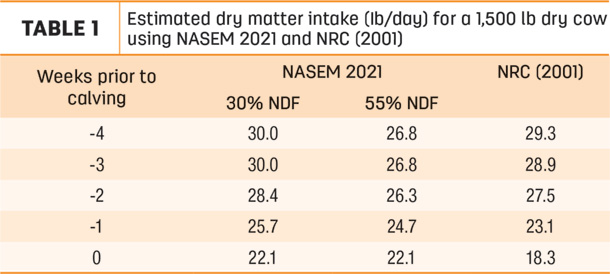
To illustrate how these adjustments are made, if NDF was increased in the diet of far-off cows from 30% to 50%, intakes would be decreased by 12%. However, close-up cows fed a low NDF diet (i.e., 30%) would have a more significant reduction in DMI than cows fed the diet with the higher NDF content (i.e., 55%), resulting in DMI of 1.65% of BW one week prior to calving for all NDF levels. The ideal level of dietary NDF during the dry period may be established by the consultant based on feed ingredients available, optimal intake and the postpartum health of the cows.
Energy and protein
Compared to previous editions, the NASEM 2021 has lowered energy and protein requirements for cows during the far-off dry period and increased requirements for energy and protein during the last three weeks of gestation (see Table 2).
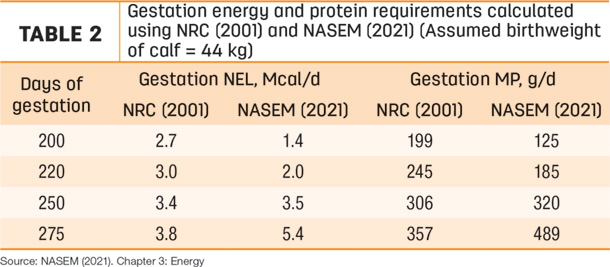
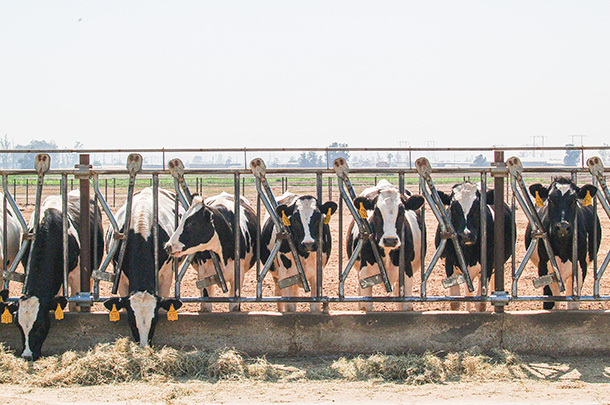 Getty Images.
Getty Images.The difference between NASEM 2021 recommendations and results observed on commercial dairies may be due to the high proportion of heifers on some dairies. The NASEM 2021 protein recommendations for pre-fresh cows considers only requirements for gestation, whereas for heifers the requirements are for both gestation and growth. A consultant familiar with the specific farm conditions would have the best knowledge to determine the MP for the dry period that would optimize animal health and production. For energy concentration recommendations, NASEM 2021 emphasizes the importance of adjusting the dietary energy based on actual DMI and body condition scores to minimize the incidence of ketosis postpartum.
Minerals and vitamins
Table 3 lists the NRC (2001) and NASEM 2021 recommended macromineral and vitamin concentrations for pre-fresh dairy cows. The NASEM 2021 values listed were developed to supply macrominerals and vitamins to meet dairy cow requirements; however, optimal cow health and postpartum milk production may vary depending on the nutritional strategy and necessitate deviation from the suggested NASEM 2021 targets.
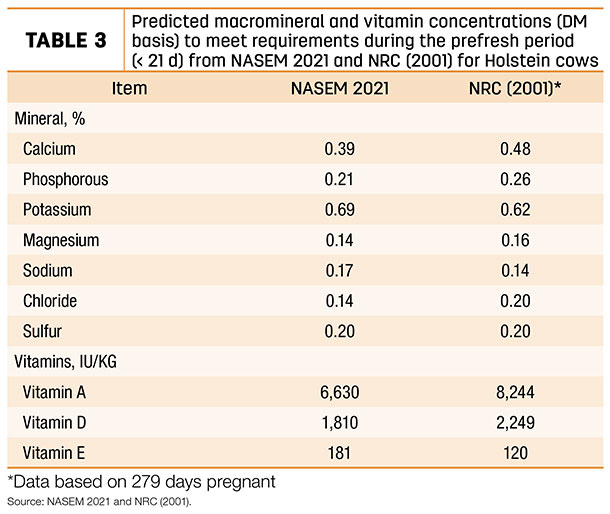
For example, the use of dietary cation-anion difference (DCAD) diets to create a compensated metabolic acidosis during the pre-fresh period significantly decreases the incidence of hypocalcemia. More specifically, decreasing DCAD by increasing chloride (0.8% to 1% of DM) and sulfur (0.4% to 0.47% of DM) concentrations above NASEM 2021 requirements reduces the incidence of subclinical hypocalcemia. In addition, depending on the DCAD strategy (i.e., different targeted levels of urine pH), varying dietary calcium between 0.65% and 1.7% has successfully improved serum calcium status in transition cows. In fact, research shows that feeding a fully acidogenic diet (targeted urine pH of 5.5 to 6.0) with dietary calcium above 1.5% of DM during the pre-fresh period significantly decreased the incidence of clinical and subclinical hypocalcemia and adverse health scores and improved measures of reproductive function. Further evidence for improved calcium metabolism was demonstrated by Amundson et al., who showed that feeding a fully acidogenic ration with high dietary calcium (2% of DM) to cows for 21 days increased the available pool of ionizable calcium compared to cows fed a fully acidogenic ration with low (0.4% of DM) or moderate (1.1% of DM) levels of dietary calcium.
The concentrations of the fat-soluble vitamins listed in Table 3 are based on the concept of adequate intake. NASEM 2021 reports adequate intake when there is insufficient information to determine animal requirements. Adequate intake represents the average daily nutrient intake that a panel of experts determined should be consumed to keep 50% of the population of animals healthy. The concept of feeding an animal to a recommended adequate intake level should not be confounded with recommended requirement levels of a ration. Whereas adequate intake is based on nutrient intake estimated to meet the requirements of one-half of the healthy group of dairy cows, the feeding recommendation is based on requirements of nearly all (97% to 98%) healthy individuals of a group of dairy cows.
Conclusions
Significant changes on NASEM 2021 from NRC (2001) related to dry cow diet recommendations are the prediction of DMI (week prior to calving instead of days pregnant and the addition of diet NDF content) and nutrient requirements during the close-up period (increased protein and energy requirements). As a practical recommendation, the NASEM 2021 is an excellent reference book for practicing nutritionists and should be considered a starting point for formulating dairy cattle diets. However, dairy nutritionists may deviate from NASEM 2021 based on individual herd history or records to maximize cow health and productivity.
References omitted but are available upon request. Click here to email an editor.
-
Rodrigo Souza
- Senior Technical Services Manager
- Phibro Animal Health Corporation
